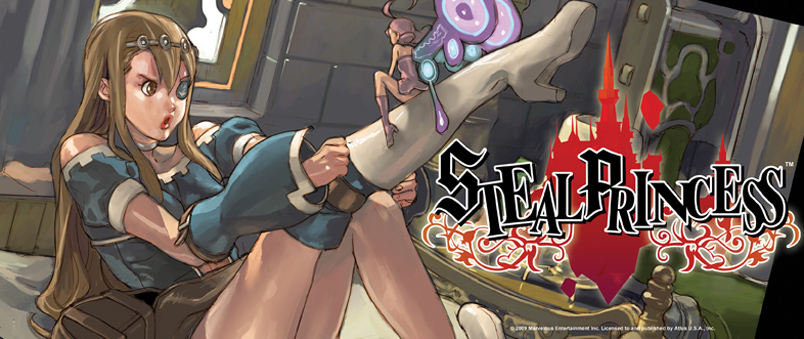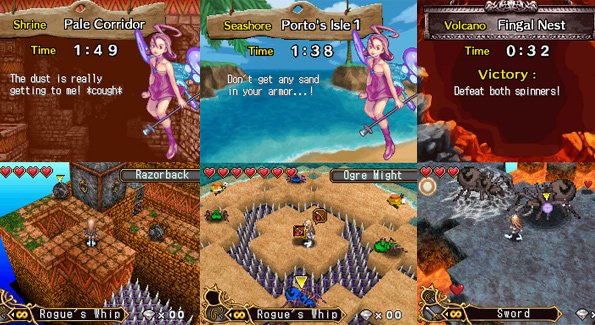There is beauty in two seemingly disparate elements melded into one seamless creation. Steal Princess aims to accomplish this task by blending genres with puzzle solving and platforming components. Genre is itself a nebulous word, which seems to lose meaning with every major release. Even Cliff Bleszinski, the creator of Gears of War 2 (a third-person shooter staple) believes the future of the shooter genre is in RPGs. The puzzle-platformer itself appears to be gaining traction with the popularity of Braid and most recently Trine. Steal Princess rests a bit uncomfortably with these two games in the border lands of genre.
Published by ever prolific Atlus, of Shin Megami Tensei fame, and developed by Climax Entertainment, Steal Princess follows the comedic exploits of Anise, a skilled young thief with an eye patch and an attitude. Like some of her adventuring predecessors, Anise is accompanied by an only moderately annoying fairy named Kukri who is enamored with the legendary hero Anise is destined to become. Her enemies consist of surprisingly nonthreatening demons, critters of various colors, all thwarting her attempts to rescue a prince.

The plot sounds trite, and for the most part it is. But make no mistake, Steal Princess is very much aware of itself, approaching what should be a hackneyed storyline with light-hearted jibing at its own expense. At times, the game is genuinely funny. Clever dialogue and the occasional piece of attractive animation evokes sincere appreciation for the world and its inhabitants, including the demons. Unfortunately, the game’s appeal wobbles atop unrefined gameplay elements.
Game progression consists of working your way through various stages, each consisting of a series of grid maps. Each map has a door Anise must open and exit through, with traditional platforming obstacles in her way. However, the puzzling task is finding out which precise route and order in which to kill enemies is necessary for escape. With whip in hand, Anise must use the land formation, enemy lay-out, and various acquired weapons to reach her goal.
The puzzle design is actually quite inventive. Many enemies can only be killed with specific weapons, but not right away. These baddies, including the swimming and flying varieties, are also tools Anise must exploit to navigate the level. The gamer iterates on this basic design with some impressive and increasingly difficult puzzles. It is not uncommon to find yourself holding the key but having no feasible path to the exit. Most maps require multiple play throughs just to scope out the territory and get a feel for the land. Like all successful puzzle games, the “aha!” moments are deeply satisfying. It’s the platforming required to bring a brilliant plan to fruition that is so frustrating.
What should be a simple application of the player’s skill becomes repeated attempts at needlessly bothersome platforming. Steal Princess is not designed for the precision its platforming requires. The static camera angle makes judging distance and timing difficult. Anise’s brief hovering and strange collision detection compounds this problem. Enemies used as platforms and launching devices seem to take up a larger amount of space than their model demands. It is not rare to see Anise hovering slightly to the right of and above an enemy attacking her with futile swings of an axe.
Anise’s whip, her main navigational tool, is finicky and consistently aggravating. The whip is imprecise, which is partially explained by the sloppy detection and camera angle. The other more obvious and almost insulting explanation for whip-frustration is the baffling control design.

Players can activate the whip in two ways. They can use the stylus to click on a target or they can press the right shoulder button. Pressing the shoulder button will whip an object detected within a certain range of Anise. This method becomes especially unreliable when there are multiple moving targets in close proximity to each other. The stylus, while slightly more precise, is a pain to use when trying to combine whipping with jumping or moving. Using the stylus to play fluidly requires an inhuman act of finger contortion.
It is strange to lament a sincerely appealing game because its playability is severely mangled. In most respects, Steal Princess should be a simple and joyful diversion for puzzle and platforming fans alike. The ability to create your own maps, which is robust in its own right, should be a selling point itself (although there are more than enough maps to keep players hopping about). But the platforming mechanics are simply not capable of supporting the puzzle design. Instead of a seamless genre-bending creation, Steal Princess is more of a shambling automaton. Like Frankenstein’s monster, Steal Princess is impressive because its creation is a daring accomplishment. It can be done; puzzle-platformers can in fact stand on their own two legs. Unfortunately, Steal Princess is a composite medley falling apart at the seams.

















